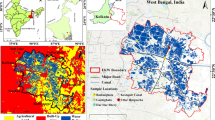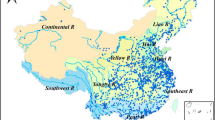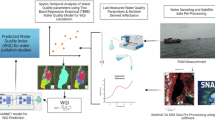Abstract
Water crises have been among the most serious environmental problems worldwide since the twenty-first century. A water crisis is marked by a severe shortage of water resources and deteriorating water quality. As an important component of water resources, lake water quality has deteriorated rapidly in the context of fast urbanization and climate change. This deterioration has altered the water ecosystem structure and influenced lake functionality. To curb these trends, various strategies and procedures have been used in many urban lakes. Among these procedures, accurate and responsive water environment monitoring is the basis of the forecasting and prevention of large-scale cyanobacteria outbreaks and improvement of water quality. To dynamically monitor and predict the outbreak of cyanobacteria in Dianchi Lake, in this study, wireless sensors networks (WSNs) and the geographic information system (GIS) are used to monitor water quality at the macro-scale and meso-scale. Historical, real-time water quality and weather condition data were collected, and a combination prediction model (adaptive grey model (AGM) and back propagation artificial neural network (BPANN)) was proposed. The correlation coefficient (R) of the simulation experiment reached 0.995. Moreover, we conducted an empirical experiment in Dianchi Lake, Yunnan, China using the proposed method. R was 0.93, and the predicting error was 4.77. The results of the experiment suggest that our model has good performance for water quality prediction and can forecast cyanobacteria outbreaks. This system provides responsive forewarning and data support for lake protection and pollution control.















Similar content being viewed by others
References
Anderson JR (1976) A land use and land cover classification system for use with remote sensor data[J]. Usgs Prof Pap 964:964
Boqiang Q, Yunlin Z, Guang G et al (2014) The key factor for lake ecological restoration analysis [J]. Prog Geogr 33(7):918–924
Cheng S, Liu J, Li L (2015) Study on anomaly water quality assessment factor based on fish movement behavior[J]. Chin J Sci Instrum 36(8):1759–1766
Evans J, Janek JF, Hunter BL (2008) Wireless sensor network design for flexible enuironmental monitoring[J]. J Eng Technol 25(1):46–52
Genbao LI, Lin LI, Pan M et al (2014) The degradation cause and pattern characteristics of Lake Dianchi ecosystem and new restoration strategy of ecoregion and step-by-step implementation[J]. J Lake Sci 26(4):485–496
Guolin Y, Bin HE (2008) Influence of geographical features in Dianchi Lake Basin water pollution [J]. Environ Sci Surv 27(5):21–23
Haiyang Z, He Z, Shaojie M (2014) Design of low power acoustic-ultrasonic compound sensor node[J]. Chin J Sci Instrum 35(10):2223–2230
IPCC (2007) Climate Change 2007: The Physical Science Basis: Working Group I Contribution to the Fourth Assessment Report of the IPCC. Cambridge University Press
Jian P, Lin WY, Yuan Z et al (2006) Effect on landscape pattern classification index [J] [25]. Land Use Geogr Sci 61(2):157–168
Karl TR, Arguez A, Huang B et al (2015) Possible artifacts of data biases in the recent global surface warming hiatus[J]. Science 348(6242):1469–1472
Klemas V (2012) Remote sensing of algal blooms: an overview with case studies[J]. J Coast Res 28(1A):34–43
Lunetta RS, Schaeffer BA, Stumpf RP et al (2015) Evaluation of cyanobacteria cell count detection derived from MERIS imagery across the eastern USA[J]. Remote Sens Environ 157:24–34
Luo Y, Yang K, Yunbo S et al (2014) Research of radiosonde humidity sensor with temperature compensation function and experimental verification[J]. Sensors Actuators A Phys 218:49–59
Matthews MW, Odermatt D (2015) Improved algorithm for routine monitoring of cyanobacteria and eutrophication in inland and near-coastal waters[J]. Remote Sens Environ 156:374–382
Olmos MA, Birch GF (2010) A novel method using sedimentary metals and GIS for measuring anthropogenic change in coastal lake environments[J]. Environ Sci Pollut Res Int 17(2):270–287
Peng G (2007) Environmental monitoring wireless sensor networks for remote sensing technology [J]. J Remote Sens 11(4):545–551
Pham SV, Leavitt PR, McGowan S et al (2008) Spatial variability of climate and land-use effects on lakes of the northern Great Plains[J]. Limnol Oceanogr 53(2):728–742
Ren L, Cui E, Sun H (2014) Temporal and spatial variations in the relationship between urbanization and water quality[J]. Environ Sci Pollut Res 21(23):13646–13655
Rui J, Xin L, Baoping Y et al (2012) Heihe River watershed hydrological sensor networks [J]. Adv Earth Sci 27(9):993–1005
Schueler TR (1994) The importance of imperviousness[J]. Watershed Protection Techniques 1(3):100–111
Shengli W, Cheng L, Jun S et al (2009) Satellite remote sensing in Taihu Lake cyanobacteria bloom meteorological factors affecting the distribution and analysis [J]. Meteorological 35(1):18–23
Stumpf RP, Davis TW, Wynne TT et al (2016) Challenges for mapping cyanotoxin patterns from remote sensing of cyanobacteria[J]. Harmful Algae 54:160–173
Sun LY, Chen YZ, Wang XQ et al (2010) Comparison of multi-sensor data application in algal bloom detection[J]. Int Congr Image Signal Proc 3:2144–2148
Voorde TVD, Jacquet W, Canters F (2011) Mapping form and function in urban areas: an approach based on urban metrics and continuous impervious surface data[J]. Landsc Urban Plan 102(3):143–155
Wu C, Murray AT (2003) Estimating impervious surface distribution by spectral mixture analysis[J]. Remote Sens Environ 84(4):493–505
Xiao R B. (2011) Modeling spatial Ddistribution of population density for urban planning[J]. China Population Resources & Environment
Xin Z, Xi C, Wanqing L et al (2014) Non-point source pollution watershed landscape pattern remote sensing sources and sinks resolve[J]. Agric Eng 2(32):191–197
Xun L, Xiaomei X, Jia H et al (2012) Point source pollution control in Dianchi Lake Basin and resolve problems [J]. Lake Sci 22(5):633–639
Yao X, Wang G, Yang W et al (2010) Dynamics of the water bloom-forming Microcystis and its relationship with physicochemical factors in Lake Xuanwu (China)[J]. Environ Sci Pollut Res 17(9):1581–1590
Yi L, Yunbo S, Kun Y et al (2014a) Humidity sensor for radiosonde and its measuring circuit[J]. Opt Precis Eng 22(11):3050–3060
Yi L, Yunbo S, Liliang Q et al (2014b) Research on atmosphere aloft temperature probing based on harmonic analysis and AC comparison methods[J]. Chin J Sci Instrum 35(4):721–729
Yi L, Kun Y, Lin D et al (2015) Research on dynamic measurement method for button contact resistance[J]. Chin J Sci Instrum 36(1):49–55
Yong L, Yang P, Hu S et al (2012) Watershed pollution prevention planning and eutrophication control strategy for Lake Dianchi[J]. Huanjing Kexue Xuebao 32(8):1962–1972
Yonghong Z, Enjie D, Yanjun H (2015) Energy balance routing algorithm for WSNs optimized with PSO[J]. Chin J Sci Instrum 36(1):78–86
Yu G, Naiming Z (2013) Kunming city urban surface runoff pollution characteristics [J]. J Environ Eng 7(7):2587–2595
Ze Y, Jianhua X, Lihua X (2006) Based on the environmental effects of ecological urban land use remote sensing images - Ecology of urban thermal environment and vegetation index as an example [J]. 26 (5): 1450–1460
Zhiqiang Z, Yue W, Chao S et al (2012) Underwater wireless sensor monitoring network for sampling and sparse approximate reconstruction[J]. Sci Instrum 33(12):2728–2734
Author information
Authors and Affiliations
Corresponding author
Additional information
Responsible editor: Suresh Pillai
Rights and permissions
About this article
Cite this article
Luo, Y., Yang, K., Yu, Z. et al. Dynamic monitoring and prediction of Dianchi Lake cyanobacteria outbreaks in the context of rapid urbanization. Environ Sci Pollut Res 24, 5335–5348 (2017). https://doi.org/10.1007/s11356-016-8155-2
Received:
Accepted:
Published:
Issue Date:
DOI: https://doi.org/10.1007/s11356-016-8155-2




